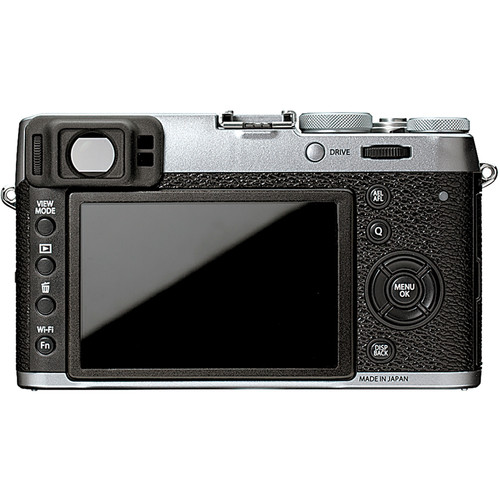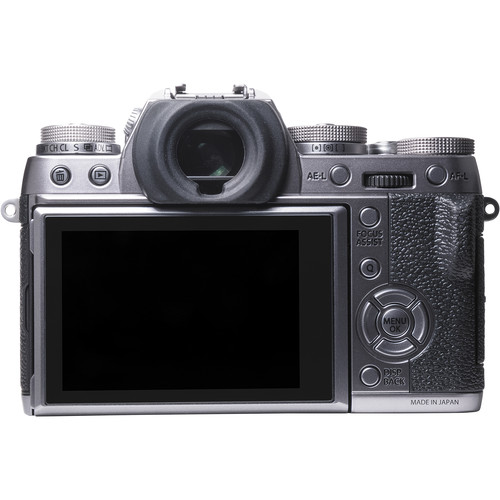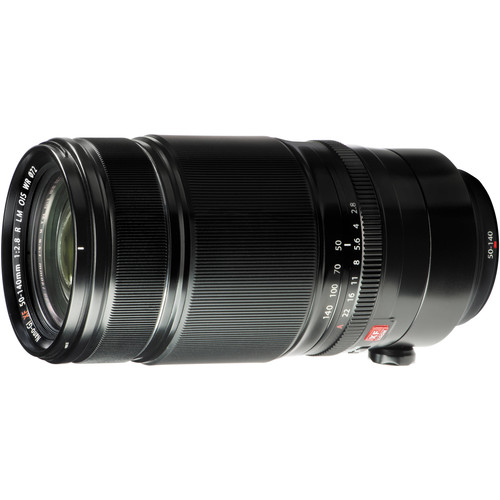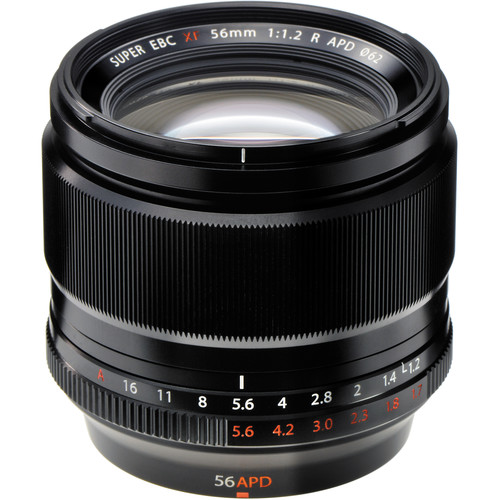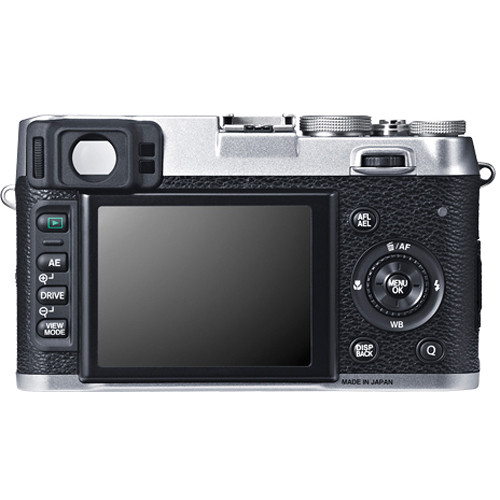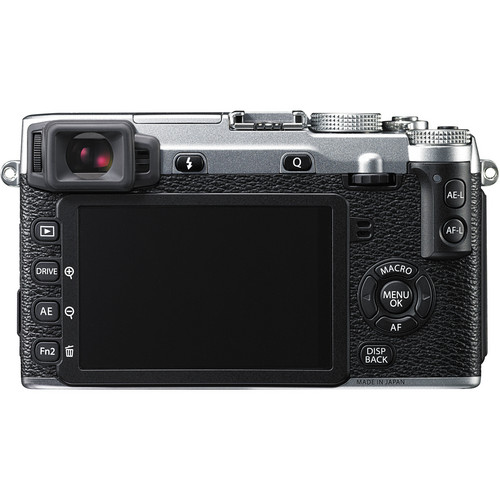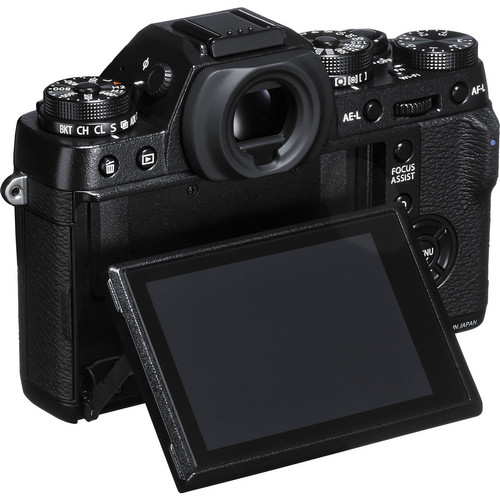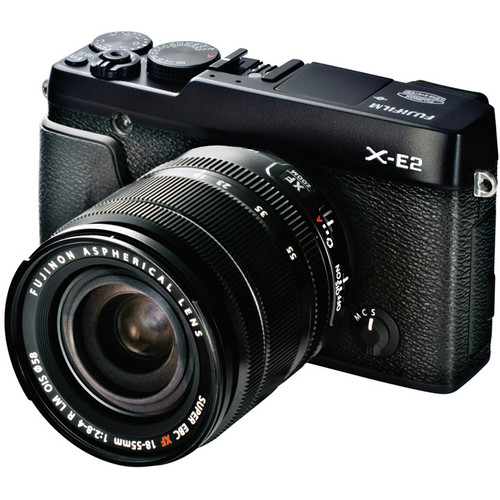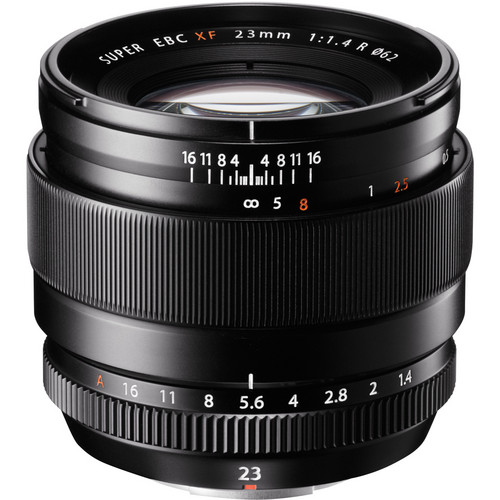If you read my x100s review, you know that I loved that camera – A LOT. However, I would never spend that kind of money for a fixed lens camera. It just makes no sense to me. However, I wanted a x100s in a X-E1 body, and it seems that Fujifilm has both listened and delivered!
A interchangeable lens camera with the X-Trans CMOS II and EXR Processor II is exactly what I wanted, and the lens line up for XF lenses keeps getting better and better. I can’t wait to get my hands on this one!!!
With a 1D X as my primary shooter, this camera might just be the one that causes me to give up my 5D Mark III in favor of a more compact second camera.

Fujifilm X-E2 KIT w/18-55mm (Black) – (Adorama)
Body Only Link – (Adorama)

Fujifilm X-E2 KIT w/18-55mm (Silver) – (Adorama)
Body Only Link – (Adorama)
*** CLICK HERE to see sample images taken with the X-E2 ***
Fujifilm X-Q1 – Perhaps my next Point & Shoot!
I loved my x10 so much that I named it my Point & Shoot of the Year a few years back, so it was a no brainer for me to get the x20. As much as I love it, it would be nice to have something that is a little smaller – especially when my wife and I are out on a formal dinner date.
Everything I see from the specs on this one sounds good, so I am excited to see it in New York next week. I’m even more excited about reviewing it!

Fujifilm X-Q1 (Black)

Fujifilm X-Q1 (Silver) – (Adorama)
Conclusion
I’m very excited about these cameras and can’t wait to review them. I really hope I can get my review unit soon and have one under the Christmas tree this holiday season!
Where to order
Click any of the links above to learn more or pre-order these cameras.
Other articles you may enjoy
If you enjoyed this article, you may also enjoy these:
Press Releases
The following are the official unedited press releases for these cameras:
FUJIFILM ONCE AGAIN REDEFINES THE PHOTOGRAPHIC EXPERIENCE WITH THE NEW X-E2
New X-E2 digital camera features high-speed hybrid AF with phase detection, lens modulation optimizer and professional movie capture
Valhalla, N.Y., October 18, 2013 – As a leader in advanced digital camera technology and outstanding image resolution, FUJIFILM North America Corporation today announced the new FUJIFILM X-E2, a premium interchangeable lens camera featuring the latest generation 16.3 Megapixel APS-C X-Trans CMOS II *1 sensor and the segment’s fastest autofocus of 0.08 seconds*2 for a truly remarkable photographic experience.
As the fifth interchangeable lens camera system introduced within the award-winning FUJIFILM X-Series, the FUJIFILM X-E2 delivers picture quality that rivals full-frame cameras with high definition image capture, Fujifilm’s legendary color reproduction and category-leading speed.
“Outstanding image quality and beautiful design are the hallmarks of the FUJIFILM X-Series experience, and today’s announcement of the new X-E2 shows Fujifilm’s unrelenting commitment to photographic excellence,” said Manny Almeida, senior vice president and general manager, FUJIFILM North America Corporation, Imaging and Electronic Imaging Divisions. “With the X-E2, photographers will immediately be amazed by its high-speed hybrid AF with phase detection, pin-sharp image quality, and improved HD movie capture for endless photographic possibilities.”
Award-winning 16.3 Megapixel APS-C X-Trans CMOS II sensor and EXR Processor II
The FUJIFILM X-E2 uses the 16.3 Megapixel APS-C X-Trans CMOS II sensor which expertly controls moiré and false color generation. This is attained by using an original color filter array with a highly randomized pixel arrangement that removes the need for an Optical Low Pass Filter (OLPF) that degrades resolution. The image quality in the X-E2 is further refined by the inclusion of the first Lens Modulation Optimizer (LMO) for interchangeable lens cameras.
The EXR Processor II in the new X-E2 more than doubles the processing speed*3 of the previous generation. It is able to harness the information taken from over 100,000 phase detection pixels incorporated in the X-Trans CMOS II to deliver extraordinary imaging capability.
This advanced technology has been made possible by the integrated development of lens, sensor and processor, and is based on the optical performance and characteristics of individual lenses. With each of these components working together, the X-E2 achieves astonishing resolution, extends dynamic range, and reduces noise at high sensitivity.
Fast and accurate focusing
The FUJIFILM X-E2 gives photographers and enthusiasts ultra-fast response times to catch even the quickest memorable moments. The X-E2 has a rapid startup time of 0.5 seconds*4, minimal shutter lag of 0.05 seconds, and high-speed continuous shooting of 7.0 fps (up to approx. 28 frames) *5.
With its auto switching AF, the X-E2 combines contrast AF with an improved phase detection AF algorithm that provides accurate capture of low-contrast subjects in low light as well as high-speed responsiveness.
Manual focus made easier
Manual focus has been made easier by the inclusion of Digital Split Image*6 technology. This helps the user achieve pin-sharp focusing by simply adjusting focus to line up the four stripes displayed in the central part of the live view. Focus Highlight Peaking allows for an outline in
high contrast areas of subjects during focusing, further assisting the photographer in achieving stunningly sharp images.
Classic design and intuitive operation
The FUJIFILM X-E2 continues the tradition of the X-Series with uncompromising craftsmanship and classic design that puts the photographer first. The X-E1 features manually adjustable shutter speed and exposure compensation dials, which has been increased to ±3 EV, for easy controls. The X-E2 also allows users to customize up to four buttons on the top and back of the camera to suit their own shooting style.
The X-E2 features a bright and accurate 2.36 million dot OLED viewfinder with Fujifilm’s original optical design for a distortion-free field of view. A premium clear 3” LCD screen with 1.04 million dot resolution and reinforced glass gives users high viewing angles and a true view of their subject.
Improved movie performance
The FUJIFILM X-E2 shoots full HD video at 1920x1080 with up to 60fps with AF tracking performance for exceptional speed, accuracy and smoothness with a high bitrate of 36Mbps. The X-E2 delivers quick focusing on subjects, even when panning and zooming. With the X-E2, film simulation settings and exposure compensation (±2 EV) can be used during movie recording.
Easy Image Transfer with WiFi® button
The FUJIFILM X-E2 includes a WiFi button that lets users transfer high quality photos and movies*7 to smartphones, tablets and computers for easy sharing on social media sites.
To connect the X-E2 to a smartphone or tablet, users can download the free dedicated “FUJIFILM Camera Application” to their iPhone™ / iPad™ or Android™ smartphone or tablet device to transfer up to 30 pictures at a time from the X-E2. The app also lets users download movies, expanding the range of options available for enjoying pictures taken with the camera.
Once paired, users can press and hold the WiFi button to begin sharing images and movies immediately to their smartphone or tablet.
The X-E2 also has an Advanced Filter function and Film Simulation modes to give users a range of creative filters and film effects to apply and achieve unique and artistic looks.
FUJIFILM X-E2 key features list:
- 16.3 million Megapixels APS-C X-Trans CMOS II Sensor
- EXR Processor II
- Start-up time of 0.5
- Shutter lag time of 0.05
- Shooting interval time of 0.7
- AF speed 0.08 seconds
- Lens Modulation Optimizer for improved image quality
- Extra high resolution 2.36 million dot OLED electronic viewfinder
- ±3 EV Exposure Compensation dial with third stops increments
- 3” (1.04 million dot) premium clear LCD (High contrast, High Brightness and Wide viewing angle)
- Built-in Super Intelligent pop-up Flash(hot shoe attachment also available for external flash)
- ISO200 - 6400, extended ISO 100, 12800, 25600, Auto(maximum ISO setting from ISO 400 – ISO6400 available)
- Q Menu shortcut button
- In-camera RAW converter
- Film simulation modes (Velvia, ASTIA, PROVIA, Monochrome, Sepia, Pro Neg.Std & Pro Neg.Hi)
- Artistic features: Multiple exposure, Panoramic shooting,Toy Camera, Miniature, Dynamic Tone, Pop Color, Soft Focus, High Key, Low Key, and Partial Color.
- Selection of Bracketing functions (AE/ISO/Dynamic Range &Film Simulation)
- Full HD Movie
- Microphone/shutter release input (φ2.5mm)
- Super Intelligent Flash
- Approximately 350 shots per battery charge
FUJIFILM X-E2 accessories list:
- Dedicated all-leather case BLC-XE1 with separate cloth wrap
- Compatible with all FUJINON X Mount lenses
- M Mount Adapter for additional lens compatibility
- Hand Grip HG-XE1
- Three dedicated flash models to choose from depending on requirements (EF-X20, EF-20, EF-42)
- Protector filters (PRF-39, PRF-52, PRF-58 and PRF-62)
- Remote release RR-90
The FUJIFILM X-E2 (body only) will be available in November 2013 for $999.95 in both black, and a two-tone black and silver.
The FUJIFILM X-E2 and XF18mm-55mm (27-84mm) F2.8-4 lens (kit) will be available in November for $1,399.95.
The FUJIFILM X-E2 uses the same FUJIFILM X-Mount as the X-Pro1, X-E1 X-M1 and X-A1, and all FUJIFILM XF and XC lenses work with all X-Series interchangeable lens cameras.
The current Fujifilm lens family includes the following FUJINON XF and XC lenses:
- XF 14mm F2.8
- XF 18mm F2.0
- XF 23mm F1.4
- XF 27mm F2.8
- XF 35mm F1.4
- XF 60mm F2.4
- XF 18-55mm F2.8-4.0 OIS
- XF 55-200mm F3.5-4.8 OIS
- XC 16-50mm F3.5-5.6 OIS
- XC 50-230mm F4.5-6.7 OIS
*1: X-Trans is a trademark or registered trademark of FUJIFILM Corporation
*2: FUJIFILM research as of September 2013. Compared with other digital cameras equipped with 4/3-inch sensor or larger, based on CIPA standards, and using internal measurement methods under high performance mode. Attached with XF14mm F2.8R lens.
*3: Compared with EXR Processor Pro
*4: In high performance mode with XF27mm F2.8 lens
*5 JPEG format: Use a card with SD speed class with class 10 or higher.
*6 Digital Split Image is a trademark or registered trademark of FUJIFILM Corporation
*7 FUJIFILM Camera Application for iOS can save movie files up to 1280 x 720
About Fujifilm
FUJIFILM North America Corporation, a marketing subsidiary of FUJIFILM Holdings America Corporation consists of four operating divisions and one subsidiary company. The Imaging Division provides consumer and commercial photographic products and services, including: photographic paper; digital printing equipment, along with service and support; personalized photo products; film; and one-time-use cameras; and also markets motion picture archival film and on-set color management solutions to the motion picture, broadcast and production industries. The Electronic Imaging Division markets consumer digital cameras, and the Graphic Systems Division supplies products and services to the graphic printing industry. The Optical Devices Division provides optical lenses for the broadcast, cinematography, closed circuit television, videography and industrial markets, and also markets binoculars. FUJIFILM Canada Inc. sells and markets a range of Fujifilm products and services in Canada. For more information, please visit www.fujifilmusa.com/northamerica, go to www.twitter.com/fujifilmus to follow Fujifilm on Twitter, or go to www.facebook.com/FujifilmNorthAmerica to Like Fujifilm on Facebook. To receive news and information direct from Fujifilm via RSS, subscribe at www.fujifilmusa.com/rss.
FUJIFILM Holdings Corporation, Tokyo, Japan, brings continuous innovation and leading-edge products to a broad spectrum of industries, including electronic imaging, digital printing equipment, medical systems, life sciences, graphic arts, flat panel display materials, and office products, based on a vast portfolio of digital, optical, fine chemical and thin film coating technologies. The company was among the top 10 companies around the world granted U.S. patents in 2012, and in the year ended March 31, 2013, had global revenues of $26.7 billion*. Fujifilm is committed to environmental stewardship and good corporate citizenship. For more information, please visit www.fujifilmholdings.com.
* At an exchange rate of 83 yen to the dollar.
All product and company names herein may be trademarks of their registered owners.
NEW FUJIFILM XQ1 COMBINES STUNNING IMAGE QUALITY WITH ULTRA PORTABILITY
Pocket-sized XQ1 features bright F1.8 4x zoom lens, 2/3” X-Trans CMOS II sensor and amazing 0.06 second AF speed
Valhalla, N.Y., October 18, 2013 – As a leader in advanced digital camera technology and outstanding image resolution, FUJIFILM North America Corporation today announced the new FUJIFILM XQ1, a premium pocket-sized digital camera with a bright FUJINON F1.8 4x zoom lens, an advanced 12 Megapixel 2/3” X-Trans CMOS II*1 sensor with phase detection, and the EXR Processor II that delivers the world’s fastest autofocus speed in its category of up to 0.06*2 seconds.
“The XQ1 combines the amazing image quality of the Fujifilm X Series with ultra-portability that makes taking beautiful pictures enjoyable anywhere,” said Manny Almeida, senior vice president and general manager, FUJIFILM North America Corporation, Imaging and Electronic Imaging Divisions. “The XQ1 is the most portable X-Series camera ever developed, and people can now experience a premium compact that easily slips into a pocket or purse.”
X-Series image quality and advanced focusing
The FUJIFILM XQ1 uses the 12 Megapixel 2/3” X-Trans CMOS II sensor that is designed to control moiré and false color generation by using an original color filter array with a highly randomized pixel arrangement. This technology removes the need for an Optical Low Pass Filter (OLPF) that degrades resolution. The image quality in the XQ1 is further enhanced by using a Lens Modulation Optimizer (LMO) for stunningly sharp pictures, as well as a 3.0 stop*3 Optical Image Stabilization for shooting in low light situations.
The newly developed FUJINON F1.8 4x zoom (25-100mm*4) is constructed with 4 aspherical and 3 extra low dispersion lenses and each lens surface is coated with HT-EBC to reduce flare and ghosting. The XQ1 also has a wide sensitivity range from ISO100 to ISO12800 so you can take realistic and vibrant images even in low light.
The EXR Processor II in the new XQ1 more than doubles the processing speed*5 of the previous generation, and it easily captures the information taken from over 100,000 phase detection pixels incorporated in the X-Trans CMOS II to deliver astonishing images.
Superb shooting speed and premium compact design
The XQ1 boasts that world’s fastest AF of 0.06 seconds, a shooting interval of just 0.3 seconds*6 between shots, and a shutter lag of 0.015 seconds to capture even the most fleeting and memorable moments.
With its auto switching AF, the XQ1 combines contrast AF with an improved phase detection AF algorithm that provides accurate capture of low-contrast subjects in low light as well as high-speed responsiveness. The XQ1 also gives users Focus Highlight Peaking that outlines high contrast areas of subjects during focusing, which helps users focus accurately for picture results that look fantastic on-screen and in print.
The XQ1 is made with outstanding craftsmanship and the classic design that the X-Series is known for, all within an ultra-small body that is 3.93” (w) x 2.3” (h) x 1.3” (d). With a sharp 920,000 dot LCD screen made of anti-reflective glass, the XQ1 gives photographers an amazing 85°vertical and horizontal viewing angles as they frame every shot.
Improved movie performance
The FUJIFILM XQ1 shoots full HD video with up to 60fps and AF tracking performance for quick and smooth focusing that records clear subjects, even when moving the camera body thanks to its dedicated image stabilization.
Easy Image Transfer with WiFi® button
The FUJIFILM XQ1 includes a WiFi button that lets users transfer high quality photos and movies*7 to smartphones, tablets and computers for easy sharing on social media sites.
To connect the XQ1 to a smartphone or tablet, users can download the free dedicated “FUJIFILM Camera Application” to their iPhone™ / iPad™ or Android™ smartphone or tablet device to transfer up to 30 pictures at a time from the XQ1. The app also lets users download movies, expanding the range of options available for enjoying pictures taken with the camera.
Once paired, users can press and hold the WiFi button to begin sharing images and movies immediately to their smartphone or tablet.
The XQ1 also has an Advanced Filter function and Film Simulation modes to give users a range of creative filters and film effects to apply and achieve unique and artistic looks.
FUJIFILM XQ1 key features list:
- 12 Megapixels 2/3” X-Trans CMOS II Sensor
- EXR Processor II
- Start-up time of 1.0
- Shutter lag time of 0.015
- Shooting interval time of 0.3
- AF speed 0.06 seconds
- F1.8-F4.9 4x optical zoom equivalent to 25-100mm in 35mm format
- 4x Intelligent Digital Zoom (16X combined with optical zoom)
- Lens Modulation Optimizer for improved image quality
- 3” (920,000 dot) premium clear LCD (High contrast, High Brightness and Wide viewing angle)
- Built-in Super Intelligent pop-up Flash
- ISO100 – 12800
- Full HD Movie
- In-camera RAW converter
- Film simulation modes (Velvia, ASTIA, PROVIA, Sepia and Monochrome)
- Artistic features: Toy Camera, Miniature, Dynamic Tone, Pop Color, Soft Focus, High Key, Low Key, and Partial Color Selection of Bracketing functions (AE/ISO/Dynamic Range &Film Simulation)
FUJIFILM XQ1 accessories list:
- Bottom leather case (Black BLC-XQ1 BC and Brown BLC-XQ1 BW)
- Waterproof case WP-XQ1 for depth to 40 meters
- O Ring Kit ORK-XQ1
The FUJIFILM XQ1 will be available in October 2013 for $499.95 in both all-black and all-silver.
*1: X-Trans is a trademark or registered trademark of FUJIFILM Corporation
*2: FUJIFILM research as of September 2013. Compared with other digital cameras equipped with 2/3-inch sensor or larger, based on CIPA standards, and using internal measurement methods under high performance mode
*3: CIPA standard
*4: 35mm format
*5: Compared with the EXR Processor Pro
*6: In High Performance Mode
*7: FUJIFILM Camera Application for iOS can save movie files up to 1280 x 720
Disclosure
If you make a purchase using links found in this article, I may make a commission. It doesn’t cost you a penny more, but it does help to support future articles like this.
NOTE: This site requires cookies and uses affiliate linking to sites that use cookies.
. Either way, your support is greatly appreciated!
This blog is intended for freelance writing and sharing of opinions and is not a representative of any of the companies whose links are provided on this site.
The opinions provided are of Ron Martinsen alone and do not reflect the view of any other entity
